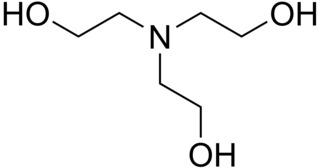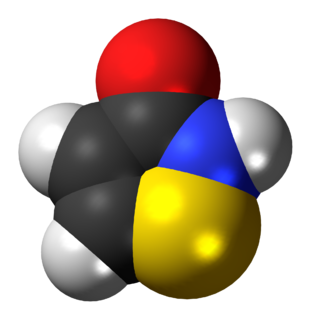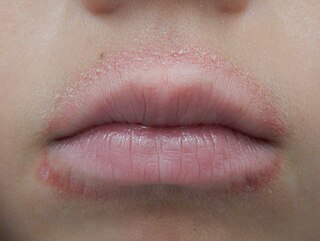
Epoxy is the family of basic components or cured end products of epoxy resins. Epoxy resins, also known as polyepoxides, are a class of reactive prepolymers and polymers which contain epoxide groups. The epoxide functional group is also collectively called epoxy. The IUPAC name for an epoxide group is an oxirane.

Thiomersal (INN), or thimerosal, is an organomercury compound. It is a well-established antiseptic and antifungal agent.

Contact dermatitis is a type of acute or chronic inflammation of the skin caused by exposure to chemical or physical agents. Symptoms of contact dermatitis can include itchy or dry skin, a red rash, bumps, blisters, or swelling. These rashes are not contagious or life-threatening, but can be very uncomfortable.

Quaternium-15 is a quaternary ammonium salt that has been used as a surfactant and preservative. It acts as an antimicrobial agent because it slowly releases formaldehyde, which is a preservative with biocidal properties.
Cocamidopropyl betaine (CAPB) is a mixture of closely related organic compounds derived from coconut oil and dimethylaminopropylamine. CAPB is available as a viscous pale yellow solution and it is used as a surfactant in personal care products. The name reflects that the major part of the molecule, the lauric acid group, is derived from coconut oil. Cocamidopropyl betaine to a significant degree has replaced cocamide DEA.

Triethanolamine, or TEA is a viscous organic compound that is both a tertiary amine and a triol. A triol is a molecule with three alcohol groups. Approximately 150,000 tonnes were produced in 1999. It is a colourless compound although samples may appear yellow because of impurities.

Tetrazepam is a benzodiazepine derivative with anticonvulsant, anxiolytic, muscle relaxant and slightly hypnotic properties. It was formerly used mainly in Austria, France, Belgium, Germany and Spain to treat muscle spasm, anxiety disorders such as panic attacks, or more rarely to treat depression, premenstrual syndrome or agoraphobia. Tetrazepam has relatively little sedative effect at low doses while still producing useful muscle relaxation and anxiety relief. The Co-ordination Group for Mutual Recognition and Decentralised Procedures-Human endorsed the Pharmacovigilance Risk Assessment Committee (PRAC) recommendation to suspend the marketing authorisations of tetrazepam-containing medicines across the European Union (EU) in April 2013. The European Commission has confirmed the suspension of the marketing authorisations for Tetrazepam in Europe because of cutaneous toxicity, effective from the 1 August 2013.

Isothiazolinone (sometimes isothiazolone) is an organic compound with the formula (CH)2SN(H)CO. A white solid, it is structurally related to isothiazole. Isothiazolone itself is of limited interest, but several of its derivatives are widely used preservatives and antimicrobials.

Hexyl cinnamaldehyde is a common additive in the perfume and cosmetic industry as aroma substance. It is found naturally in the essential oil of chamomile. It is a pale yellow to yellow liquid to solid, which is nearly insoluble in water but soluble in oils. The commercial material often contains low levels of 2,6-di-tert-butyl-4-methoxyphenol as a stabilizer.

A formaldehyde releaser, formaldehyde donor or formaldehyde-releasing preservative is a chemical compound that slowly releases formaldehyde. Formaldehyde-releasers are added to prevent microbial growth and extend shelf life. The intent of these compounds is that they release formaldehyde at levels that suppress microbial growth but sufficiently low to not threaten humans. The use of these chemicals in cosmetics has elicited controversy.

Dimethylaminopropylamine (DMAPA) is a diamine used in the preparation of some surfactants, such as cocamidopropyl betaine which is an ingredient in many personal care products including soaps, shampoos, and cosmetics. BASF, a major producer, claims that DMAPA-derivatives do not sting the eyes and makes a fine-bubble foam, making it appropriate in shampoos.

DMDM hydantoin is an antimicrobial formaldehyde releaser preservative with the trade name Glydant. DMDM hydantoin is an organic compound belonging to a class of compounds known as hydantoins. It is used in the cosmetics industry and found in products like shampoos, hair conditioners, hair gels, and skin care products.

Cocamidopropyl hydroxysultaine (CAHS) is a synthetic amphoteric surfactant from the hydroxysultaine group. It is found in personal care products. It has uses as a foam booster, viscosity builder, and an antistatic agent.

Iodopropynyl Butyl Carbamate (IPBC) is a water-soluble preservative used globally in the paints & coatings, wood preservatives, personal care, and cosmetics industries. IPBC is a member of the carbamate family of biocides. IPBC was invented in the 1970s and has a long history of effective use as an antifungal technology.

The Nickel Directive was a European Union directive regulating the use of nickel in jewellery and other products that come into contact with the skin. Since 1 June 2009, it has been subsumed into the REACH Regulation, specifically item 27 of Annex XVII to that regulation. Nevertheless, the term Nickel Directive is still used to refer to the restrictions on nickel usage and the prescribed test method for quantifying nickel release from products EN 1811.

Nickel allergy or nickel allergic contact dermatitis (Ni-ACD) is a form of allergic contact dermatitis (ACD) caused by exposure to the chemical element nickel. It typically causes a rash that is red and itchy and that may be bumpy or scaly. The main treatment is avoiding contact with nickel-releasing metals, such as wearing inexpensive jewelry.

Lip licker's dermatitis is a type of skin inflammation around the lips due to damage by saliva from repetitive lip licking and is classified as a subtype of irritant contact cheilitis. The resulting scaling, redness, chapping, and crusting makes a well-defined ring around the lips. The rash may extend as far as the tongue can reach and usually does not occur at the corners of the mouth. It commonly occurs during winter months but some people can have it year-round if lip licking is a chronic habit.

Metal allergies inflame the skin after it has been in contact with metal. They are a form of allergic contact dermatitis. They are becoming more common, as of 2021, except in areas with regulatory countermeasures.
1,4-Butanediol diglycidyl ether (B14DODGE) is an organic chemical in the glycidyl ether family. It is aliphatic and a colorless liquid. It has two epoxide (oxirane) groups per molecule. Its main use is in modifying epoxy resins especially viscosity reduction.
1,6-Hexanediol diglycidyl ether is an organic chemical in the glycidyl ether family. It is aliphatic compound that is a colorless liquid. It has two epoxide (oxirane) groups per molecule. Its main use is in modifying epoxy resins especially viscosity reduction whilst flexibilizing. It is REACH registered.
















